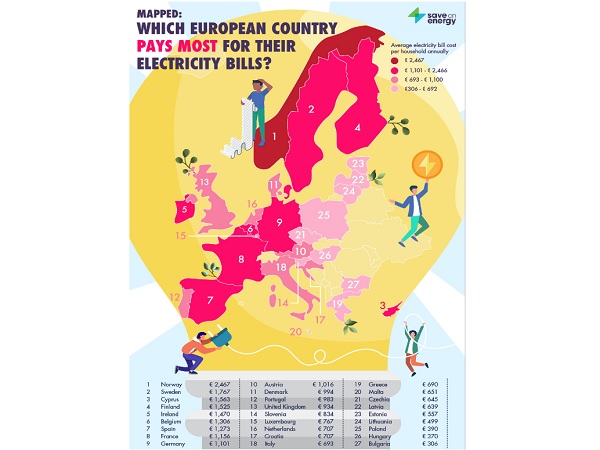 Credit: SaveOnEnergy
Credit: SaveOnEnergy
In its study on electricity bills across Europe, energy switiching site Save On Energy revealed that Luxembourg residents spent the lowest percentage (2.1%) of their salary on electricity bills annually.
SaveOnEnergy.com/uk utilised data from Eurostat and Odysee-mure to analyse household electricity costs per kWh alongside the consumption of electricity per household to discover which European country pays the most for their electricity bills.
According to its findings, the most expensive electricity bill in Europe can be found in Norway, where residents can expect to pay €2,467 per year for their electricity. Compared to the country’s average salary (€39,125), Norwegians can expect to spend 6.3% of their annual salary on electricity bills. Sweden took the second spot, with residents paying €1,767 for their electricity bills annually - or 7.2% of their annual salary. Cyprus ranked third, with electricity bills costing an average of €1,563 annually, i.e. 9.6% of their salary - the third highest percentage when taking average salary into account, just after Portugal (9.8%) and Croatia (9.7%).
Europe's cheapest electricity bills can be found in Bulgaria, at €306 per year - €2,161 cheaper than Norway. However, this equates to around 7.2% of Bulgarian residents' annual salary, putting them among the top 10 of all countries considered. Hungary is home to the second most affordable electricity bills in Europe, costing around €370 on average per dwelling each year - or 6.3% of residents' annual salary. The third cheapest electricity bills were found in Poland, at €390 per household each year - or 5.5% of resident's annual salary.
Whilst Luxembourg had the 13th cheapest electricity bills (€767), households were found to spend just 2.1% of their salary on such bills annual - the lowest in Europe.
Methodology
SaveOnEnergy used Eurostat's household energy prices in the EU report from May 2020 to find the household electricity prices for each European country in the second half of 2019. These figures include all taxes and levies. To establish the electricity consumption per dwelling for several EU countries in 2000, the website used data from Odysee-mure. This source was also used to find the percentage / year change in electricity consumption per dwelling from 2000-2008 for the same countries. The year-over-year growth rates were then used to project the electricity consumption per dwelling for each household in 2019. The mean and median salary for each European country studied was found using appsso.eurostat.ec.europa.eu/nui/show.do?dataset=ilc_di03&lang=en. Figures for 2019 were unavailable for Finland, Hungary and the United Kingdom, so 2018 figures were used.
The study took into account 27 European countries. Due to a lack of data, the following countries were not included: Albania, Bosnia and Herzegovina, Georgia, Iceland, Kosovo, Liechtenstein, Moldova, Montenegro, North Macedonia, Serbia, Slovakia, Turkey, Romania and Ukraine.








